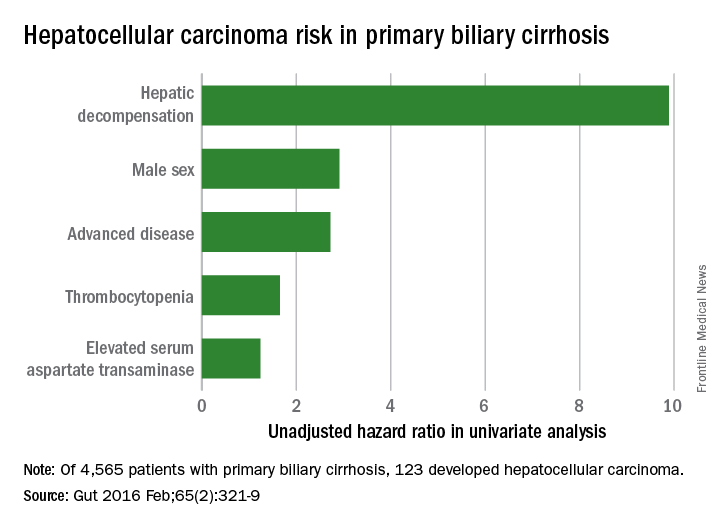User login
Biochemical nonresponse was the most significant predictor of future risk for developing hepatocellular carcinoma among an international cohort of patients with primary biliary cirrhosis (PBC).
In a multivariable analysis, nonresponse to treatment of PBC after 12 months had a hazard ratio of 3.44 (P less than .0001) for development of hepatocellular carcinoma (HCC) in the multicenter study involving 4,565 patients and an observation period of more than 40 years, said Dr. Palak J. Trivedi of the Centre for Liver Research at the University of Birmingham (England) and his associates (Gut. 2016 Feb;65[2]:321-9).
A total of 123 study patients developed HCC, for an incidence of 3.4 cases per 1,000 patient-years. In a univariate analysis, factors at diagnosis of PBC that were associated with future HCC were hepatic decompensation (HR, 9.89), male sex (HR, 2.91), advanced disease (HR, 2.72), thrombocytopenia (HR, 1.65), and elevated serum aspartate transaminase (HR, 1.24).
Nontreatment with ursodeoxycholic acid was not associated with HCC development, but biochemical nonresponse was predictive in both early-stage and advanced disease, and when only male patients were considered, Dr. Trivedi and his associates noted.

PBC patients who do not respond to ursodeoxycholic acid (UDCA) therapy might have high plasma concentrations of bile acids – in particular, chenodeoxycholic acid – because there is incomplete replacement by UDCA, or UDCA is not completely conjugated with taurine. This in turn could also contribute to both the null response and the induction of carcinogenesis via intrahepatic accumulation of bile acids.
Dr. Alejandra Altamirano-Barrera of the liver research unit at Medica Sur Clinic and Foundation, Mexico City, and associates commented on Dr. Trivedi’s study in Annals of Hepatology (2016;15[3]:453-4).
PBC patients who do not respond to ursodeoxycholic acid (UDCA) therapy might have high plasma concentrations of bile acids – in particular, chenodeoxycholic acid – because there is incomplete replacement by UDCA, or UDCA is not completely conjugated with taurine. This in turn could also contribute to both the null response and the induction of carcinogenesis via intrahepatic accumulation of bile acids.
Dr. Alejandra Altamirano-Barrera of the liver research unit at Medica Sur Clinic and Foundation, Mexico City, and associates commented on Dr. Trivedi’s study in Annals of Hepatology (2016;15[3]:453-4).
PBC patients who do not respond to ursodeoxycholic acid (UDCA) therapy might have high plasma concentrations of bile acids – in particular, chenodeoxycholic acid – because there is incomplete replacement by UDCA, or UDCA is not completely conjugated with taurine. This in turn could also contribute to both the null response and the induction of carcinogenesis via intrahepatic accumulation of bile acids.
Dr. Alejandra Altamirano-Barrera of the liver research unit at Medica Sur Clinic and Foundation, Mexico City, and associates commented on Dr. Trivedi’s study in Annals of Hepatology (2016;15[3]:453-4).
Biochemical nonresponse was the most significant predictor of future risk for developing hepatocellular carcinoma among an international cohort of patients with primary biliary cirrhosis (PBC).
In a multivariable analysis, nonresponse to treatment of PBC after 12 months had a hazard ratio of 3.44 (P less than .0001) for development of hepatocellular carcinoma (HCC) in the multicenter study involving 4,565 patients and an observation period of more than 40 years, said Dr. Palak J. Trivedi of the Centre for Liver Research at the University of Birmingham (England) and his associates (Gut. 2016 Feb;65[2]:321-9).
A total of 123 study patients developed HCC, for an incidence of 3.4 cases per 1,000 patient-years. In a univariate analysis, factors at diagnosis of PBC that were associated with future HCC were hepatic decompensation (HR, 9.89), male sex (HR, 2.91), advanced disease (HR, 2.72), thrombocytopenia (HR, 1.65), and elevated serum aspartate transaminase (HR, 1.24).
Nontreatment with ursodeoxycholic acid was not associated with HCC development, but biochemical nonresponse was predictive in both early-stage and advanced disease, and when only male patients were considered, Dr. Trivedi and his associates noted.

Biochemical nonresponse was the most significant predictor of future risk for developing hepatocellular carcinoma among an international cohort of patients with primary biliary cirrhosis (PBC).
In a multivariable analysis, nonresponse to treatment of PBC after 12 months had a hazard ratio of 3.44 (P less than .0001) for development of hepatocellular carcinoma (HCC) in the multicenter study involving 4,565 patients and an observation period of more than 40 years, said Dr. Palak J. Trivedi of the Centre for Liver Research at the University of Birmingham (England) and his associates (Gut. 2016 Feb;65[2]:321-9).
A total of 123 study patients developed HCC, for an incidence of 3.4 cases per 1,000 patient-years. In a univariate analysis, factors at diagnosis of PBC that were associated with future HCC were hepatic decompensation (HR, 9.89), male sex (HR, 2.91), advanced disease (HR, 2.72), thrombocytopenia (HR, 1.65), and elevated serum aspartate transaminase (HR, 1.24).
Nontreatment with ursodeoxycholic acid was not associated with HCC development, but biochemical nonresponse was predictive in both early-stage and advanced disease, and when only male patients were considered, Dr. Trivedi and his associates noted.

FROM GUT
